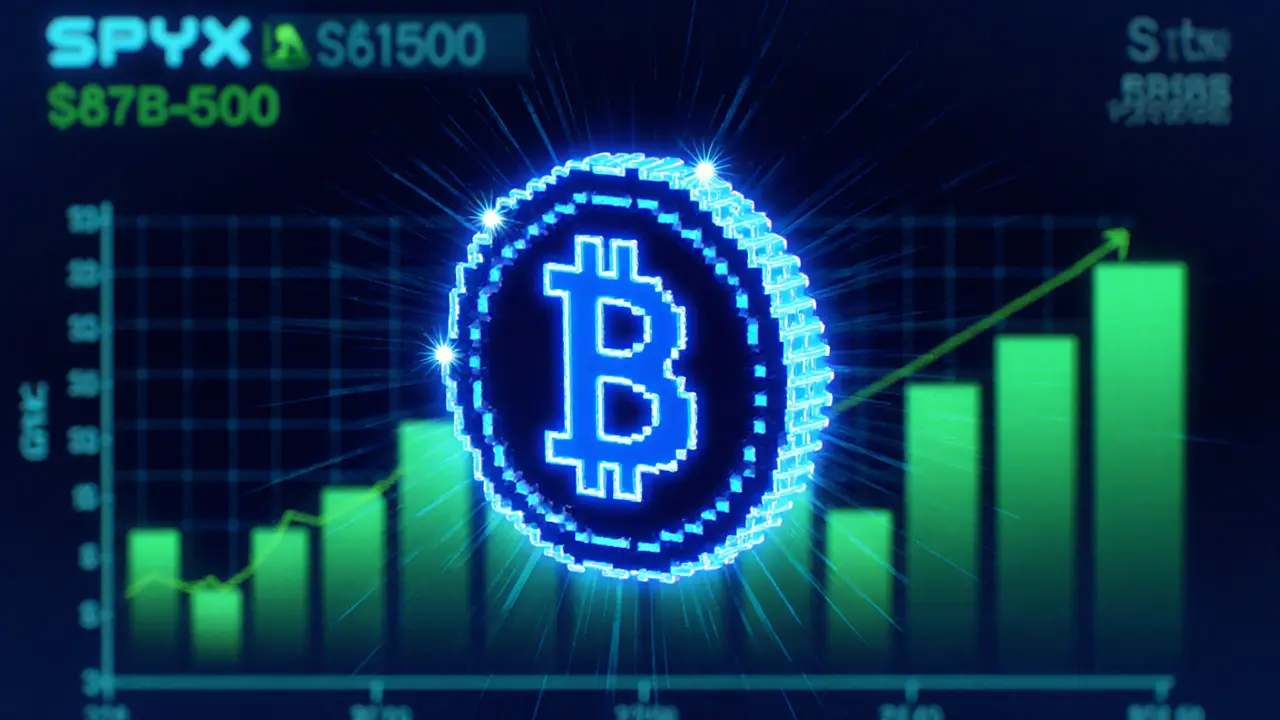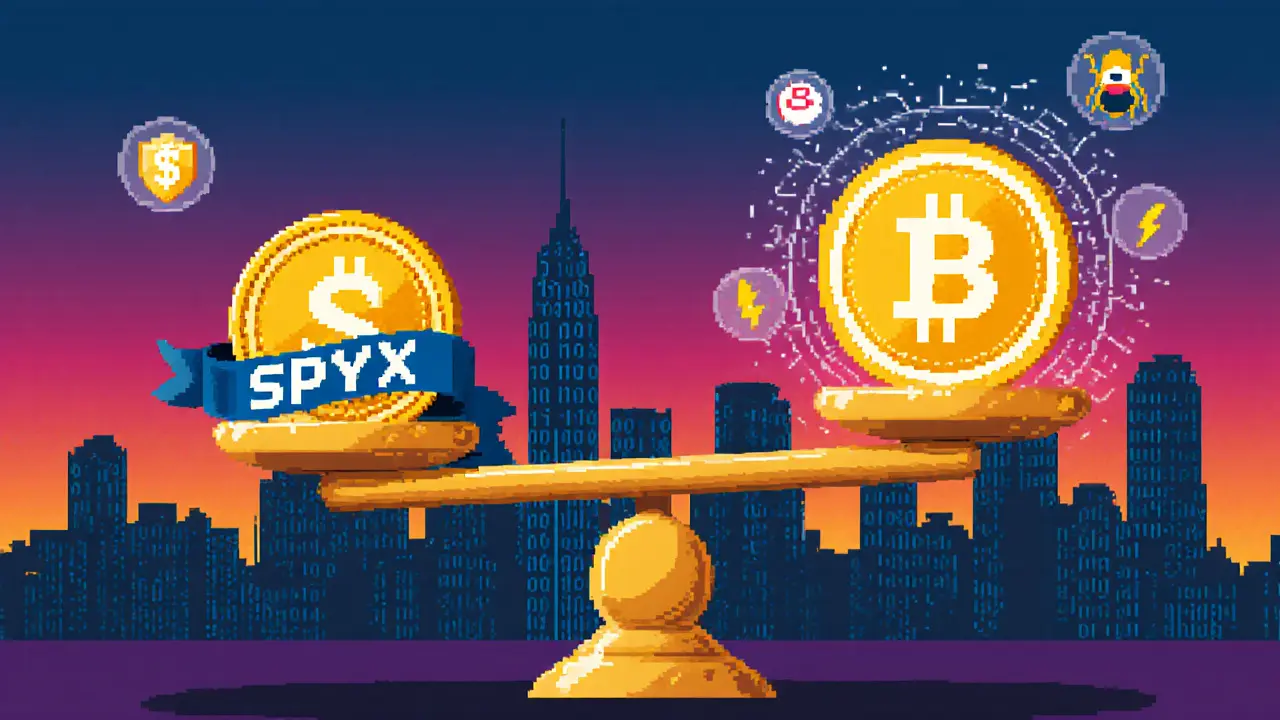Posted By Tristan Valehart On 27 May 2025 Comments (19)

SPYX Token Value Calculator
SPYX Token Information
SPYX is a dual-chain tracker certificate that mirrors the SPDR S&P 500 ETF (SPY). Current market price: $670
Calculate the value of your SPYX holdings based on current market price.
Calculated Value
Quick Facts
- SPYX is a dual‑chain tracker certificate that mirrors the SPDR S&P 500 ETF (SPY).
- It runs on Solana SPL as the primary network and also exists as an ERC‑20 token on Ethereum.
- Current market price (Oct12025) is about $670 per token.
- Buyable via Binance Web3 Wallet using stablecoins.
- Offers 24/7 crypto‑style trading but adds smart‑contract and regulatory risk.
SP500 tokenized ETF is a new way for crypto investors to hold a slice of the U.S. stock market without leaving their digital wallets.
What is SPYX?
When you see the ticker SPYX (the SP500 tokenized ETF issued by xStock), think of it as a digital replica of the popular SPDR S&P 500 ETF Trust (ticker SPY, tracks the S&P 500 Index). Instead of buying shares through a brokerage, you purchase a blockchain‑based certificate that moves one‑for‑one with the underlying ETF’s net asset value.
How tokenization works
The tokenization process locks the economic rights of a real‑world SPY share into a smart contract. Each SPYX token represents a fractional claim on the ETF’s holdings, dividends, and price movements. The smart contract audits the reserve of SPY shares held by the issuer, ensuring a 1:1 backing ratio. Whenever the SPY price shifts, the smart contract updates the SPYX price automatically, preserving price parity across both Solana and Ethereum.
Dual‑chain architecture: Solana and Ethereum
SPYX’s primary network is Solana (high‑throughput, low‑fee blockchain). Solana’s sub‑second finality keeps transaction costs near $0.0005, which is ideal for frequent trading. To reach users locked into the broader DeFi ecosystem, the token also exists as an ERC‑20 (Ethereum’s token standard) on the Ethereum (the most widely supported smart‑contract platform). This dual‑chain model gives investors flexibility: low‑cost Solana swaps or integration with Ethereum‑centric protocols like Uniswap, Aave, and Compound.

Buying and storing SPYX
Most crypto‑savvy users acquire SPYX through the Binance Web3 Wallet (a non‑custodial wallet that supports both Solana SPL and ERC‑20 tokens). The workflow is straightforward:
- Fund your Binance account with a stablecoin (USDC, USDT, or BUSD).
- Open the Web3 Wallet, select the Solana network for the lowest gas fees.
- Swap the stablecoin for SPYX at the listed market price.
- Keep the token in your personal wallet or supply it to DeFi platforms for yield‑earning strategies.
Because the token lives on a public blockchain, you retain full control of the private keys. No traditional brokerage account or KYC beyond the exchange’s onboarding is required.
SPYX vs. a traditional SPY ETF
| Feature | SPYX (tokenized) | SPY (ETF) |
|---|---|---|
| Access method | Crypto wallet (Solana or Ethereum) | Brokerage account / retirement plan |
| Trading hours | 24/7 on-chain markets | U.S. market hours (9:30am‑4:00pm ET) |
| Transaction cost | ~$0.0005 on Solana, $1‑$3 on Ethereum | ~0.09% expense ratio + brokerage commission |
| Regulatory backing | Tokenized security, issuer holds 1:1 SPY reserve | SEC‑registered open‑ended fund |
| Dividends | Distributed automatically via smart contract (usually weekly) | Paid quarterly to fund shareholders |
| Smart‑contract risk | Yes - code bugs, network congestion | No - managed by fund administrator |
Risks and regulatory considerations
While the token offers convenience, it also introduces new risk vectors:
- Smart‑contract vulnerabilities: A coding flaw could freeze or misallocate tokens.
- Network dependency: Solana outages (rare but impactful) can halt trading.
- Regulatory uncertainty: Tokenized securities sit in a gray area in many jurisdictions; future rules could affect liquidity.
- Custody risk: Lose your private key and the token is irretrievable.
Investors should treat SPYX as a complement to, not a replacement for, a traditional brokerage position, especially if they need the safety net of a regulated fund.
Price outlook and volatility
As of October12025, SPYX traded around $670, already surpassing the 2025 maximum forecast of $538.90 from early models. Price‑prediction services such as Coinlore show a wild range: a low of $338.84 and a high of $538.90 for 2025, with 2026‑2028 targets swinging between $388 and $693. Long‑term AI‑driven models even predict a potential peak near $4,558 by 2040, though the downside could dip below $7. Such extremes reflect the hybrid nature of the asset - part equity, part crypto.
Short‑term traders monitor typical crypto indicators (RSI, MACD, Fibonacci retracements) on both Solana and Ethereum price charts. The token’s correlation to SPY remains tight (Pearson r≈0.99) in normal market conditions, so any major equity market move mirrors in SPYX almost instantly.
Who should consider SPYX?
If you fit one of these profiles, SPYX might be worth a look:
- Crypto‑native investors who want S&P 500 exposure without converting to fiat.
- DeFi participants seeking to collateralize a broad‑market asset for loans or yield farms.
- Tech‑savvy professionals who value 24/7 trading and programmable features (e.g., auto‑rebalancing via smart contracts).
- Long‑term believers in tokenized securities who accept higher regulatory risk for potential liquidity benefits.
Conversely, if you prefer the ultra‑secure environment of a regulated fund, need guaranteed dividend schedules, or cannot tolerate smart‑contract bugs, stick with a traditional SPY purchase.

Frequently Asked Questions
What does SPYX actually represent?
Each SPYX token is a blockchain‑based certificate that is fully backed by one share of the SPDR S&P 500 ETF (SPY). The token’s price moves in lockstep with the ETF’s net asset value.
Can I earn dividends from SPYX?
Yes. The smart contract automatically distributes dividend payments (usually converted to USDC) to token holders on a weekly basis, mirroring the quarterly payouts of SPY.
Do I need a special wallet?
A non‑custodial wallet that supports Solana SPL or Ethereum ERC‑20 tokens is required. Binance Web3 Wallet, Phantom (Solana), and MetaMask (Ethereum) are popular choices.
How does SPYX differ from buying SPY on a brokerage?
SPYX trades 24/7 on-chain, incurs minimal transaction fees on Solana, and can be stored directly in a crypto wallet. Traditional SPY requires a brokerage, adheres to U.S. market hours, and carries a small expense ratio.
Is SPYX safe from regulatory crackdowns?
The token is issued as a regulated security, with the issuer holding a 1:1 reserve of SPY shares. However, global regulatory frameworks for tokenized securities are still evolving, so future changes could affect trading or custody.
By understanding how the SP500 tokenized ETF works, where it lives on the blockchain, and the trade‑offs it brings, you can decide whether SPYX fits into your portfolio strategy.


Darrin Budzak
May 27, 2025 AT 02:38SPYX is an interesting bridge between traditional ETFs and crypto, especially for folks who already hold stablecoins. The low fees on Solana make it tempting for small‑scale traders.
Eugene Myazin
May 29, 2025 AT 10:11Seeing a token that tracks the S&P 500 24/7 is pretty cool, especially when you can move it around in a DeFi wallet. It gives crypto‑savvy people a legit way to get broad market exposure without a brokerage. Just keep an eye on the smart‑contract audits, though.
Latoya Jackman
May 31, 2025 AT 12:11The tokenized structure offers a one‑for‑one backing with SPY shares, which is reassuring from a compliance standpoint. However, the added smart‑contract layer does introduce an extra vector of risk that traditional investors may find uncomfortable.
Nilesh Parghi
June 2, 2025 AT 08:38If you think about ownership as a spectrum, SPYX extends that spectrum onto the blockchain, blurring the line between digital and real assets. It’s a reminder that definitions of “possession” evolve with technology.
C Brown
June 4, 2025 AT 02:18Oh great, another crypto gimmick that pretends to be a “real” investment while hiding behind fancy buzzwords. Let’s see how long it lasts before regulators step in.
Raphael Tomasetti
June 5, 2025 AT 17:11SPYX leverages Solana’s low‑latency finality, enabling sub‑second settlements that traditional ETFs can’t match.
Jenny Simpson
June 7, 2025 AT 05:18While everyone gushes about on‑chain 24/7 trading, the underlying liquidity still depends on centralized exchanges that could restrict withdrawals at any moment.
Sabrina Qureshi
June 8, 2025 AT 14:38SPYX, crypto, ETFs, tokens, smart contracts, dividends, volatility-everything, everything, everything!
Rahul Dixit
June 9, 2025 AT 21:11Don’t be fooled by the “regulation‑backed” hype; the moment a government decides that tokenized securities are illegal, you’ll be left holding a piece of code with no real value.
CJ Williams
June 11, 2025 AT 00:58Hey, I get the concerns-big‑gov moves can be scary 😅-but remember that the issuer actually holds the SPY shares in reserve, so even if the token’s status changes, the underlying asset still exists. It’s a safety net worth considering.
mukund gakhreja
June 12, 2025 AT 01:58Look, if you’re willing to trust a piece of Solidity on Solana, you might as well trust a pizza delivery guy with your retirement funds. Just kidding-actually, double‑check the audit reports.
Michael Ross
June 13, 2025 AT 00:11For long‑term investors, the added smart‑contract risk might outweigh the convenience of 24/7 access, especially when traditional ETFs already have low expense ratios.
Aman Wasade
June 13, 2025 AT 19:38Sure, on‑chain trading sounds fun, but if you can’t handle a tiny network outage, you might end up missing out on the next market move.
Ron Hunsberger
June 14, 2025 AT 12:18From a technical standpoint, the dual‑chain implementation ensures compatibility with both Solana‑based DEXs and Ethereum‑based protocols, giving holders flexibility in liquidity provision.
Lana Idalia
June 15, 2025 AT 02:11Honestly, anyone who thinks tokenizing the S&P 500 is revolutionary is just missing the bigger picture-real innovation is in how these tokens can be composably used in DeFi strategies.
Janelle Hansford
June 15, 2025 AT 13:18If you’re already active in yield farming, adding SPYX as collateral can boost your returns, but always keep a buffer for potential smart‑contract exploits.
Krystine Kruchten
June 15, 2025 AT 21:38While the token offers convenience, it's crucial to regularly audit the backing reserves; any discrepancy could lead to severe market repercussions.
Mangal Chauhan
June 16, 2025 AT 03:11In summary, SPYX provides a novel on‑chain gateway to the S&P 500 📈; however, investors should balance the allure of continuous trading against the inherent regulatory and technical risks.
Narender Kumar
June 16, 2025 AT 05:58Esteemed members of this discourse, the emergence of SPYX signifies a profound metamorphosis in the nexus of traditional finance and decentralized technology. It is no mere token; it is an emblem of the relentless march toward digitization of securities that hitherto were confined to the vaulted halls of regulated exchanges. By encapsulating each share of the venerable SPDR S&P 500 ETF within a blockchain‑anchored certificate, the instrument ostensibly bestows upon the holder a duality of ownership-both legal and cryptographic. Yet, this very duality summons a cascade of considerations that demand scrupulous examination. The sanctity of the 1:1 backing ratio rests upon the fiduciary vigilance of the issuer, whose custodial obligations must be transparent and auditable. Moreover, the smart‑contract substrate, while lauded for its immutable execution, is not impervious to latent vulnerabilities that could, under adversarial conditions, precipitate loss of capital. The divergent governance frameworks of Solana and Ethereum introduce an additional layer of complexity, for each network operates under distinct consensus mechanisms and threat models. Concurrently, the regulatory milieu surrounding tokenized securities remains nascent, with jurisdictions worldwide poised to sculpt disparate compliance regimes. Consequently, investors must navigate a labyrinthine landscape wherein legal certainty and technological assurance are in perpetual flux. The allure of sub‑cent transaction fees and ceaseless market access must be weighed against the specter of network congestion or outright outages, phenomena not alien to high‑throughput chains. Furthermore, the tax implications of transacting in a token that mirrors an on‑shore ETF may diverge sharply from traditional avenues, necessitating diligent counsel. In sum, while SPYX embodies an audacious stride toward financial inclusivity, it simultaneously exhorts us to exercise prudence, vigilance, and an unwavering commitment to due diligence. May our collective wisdom guide us through this brave new realm of tokenized assets.